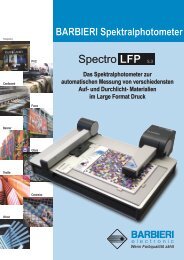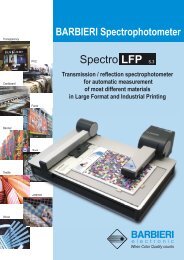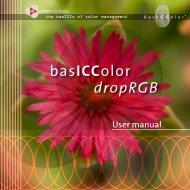basiccolor display
basiccolor display
basiccolor display
You also want an ePaper? Increase the reach of your titles
YUMPU automatically turns print PDFs into web optimized ePapers that Google loves.
asICColor <strong>display</strong><br />
by Color Solutions Software<br />
Such transformations are called Chromatic Adaptation<br />
Transforms (CATs). There has been a significant amount of<br />
research in determining CATs that are able to accurately<br />
predict color appearance across different illuminants. The<br />
transforms currently in use are based on minimizing percep-<br />
tual error of experimental corresponding color data sets.<br />
None<br />
is not really no CAT, it rather means: No other than the pre-<br />
ferred ICC chromatic adaptation method.<br />
von Kries<br />
The von Kries CAT assumes that chromatic adaptation is in-<br />
deed an independent gain control of the cone<br />
responses of the human visual system, and that the scaling<br />
is based on the ratio of the cone responses of the illumi-<br />
nants. Visual result: On a monitor calibrated to a higher color<br />
temperature, all colors appear (compared to CAT „None“) a<br />
bit warmer and more saturated. The opposite is the case for<br />
monitors calibrated to a lower color temperature than D50.<br />
linear Bradford<br />
A widely used newer chromatic adaptation transform is the<br />
Bradford transform. It was empirically derived by Lam from<br />
a set of corresponding colors as determined from 58 dyed<br />
5
















